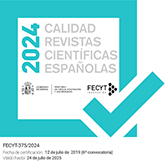Variables lingüísticas de la comprensibilidad, el acento extranjero y la fluidez en el español como L2. Diferencias en función del tipo de oyente y del grado de desempeño
DOI:
https://doi.org/10.3989/loquens.2020.075Palabras clave:
comprehensibility, accentedness, fluency, L2 Spanish, raters, ability levelsResumen
Este estudio se propone descubrir qué variables lingüísticas se relacionan de forma más intensa con la comprensibilidad, el acento extranjero y la fluidez en el español como L2, y cómo los resultados pueden variar además en función del tipo de oyente (experto o no experto) y del grado de desempeño de los hablantes en estas dimensiones. Con este fin, 40 anglohablantes nativos que tienen el español como L2 describieron oralmente una historieta gráfica que fue posteriormente evaluada mediante escalas de 9 niveles por cuatro grupos de jueces. Los dos primeros, compuestos por 109 jueces no expertos y 42 expertos, evaluaron la comprensibilidad, el acento extranjero y la fluidez. Por su parte, los dos últimos grupos, integrados por 35 fonetistas y 35 lingüistas, se encargaron de analizar y puntuar un total de 14 variables lingüísticas (7 por grupo) relacionadas con la pronunciación, las disfluencias y los aspectos lexicogramaticales y discursivos. Los resultados revelan que la comprensibilidad se asocia a una gran variedad de elementos, mientras que el acento extranjero viene determinado especialmente por los aspectos segmentales y la fluidez por el tempo. Asimismo, la repercusión de los parámetros lingüísticos varía en función del grado de desempeño de los hablantes, y existen diferencias entre los jueces no expertos y expertos, ya que los primeros se ven más afectados por la pronunciación y los expertos por el léxico y la gramática.
Descargas
Citas
Allison, P. D. (1999). Multiple Regression: A Primer. Thousand Oaks: Pine Forge Press, Inc.
Bergeron, A. y Trofimovich, P. (2017). Linguistic Dimensions of Accentedness and Comprehensibility: Exploring Task and Listener Effects in Second Language French. Foreign Language Annals, 50(3), 547-566. https://doi.org/10.1111/flan.12285
Bosker, H. R., Pinget, A.-F., Quene, H., Sanders, T. y de Jong, N. H. (2013). What makes speech sound fluent? The contributions of pauses, speed and repairs. Language Testing, 30(2), 159-175. https://doi.org/10.1177/0265532212455394
Celce-Murcia, M., Brinton, D., Goodwin, J. y Griner, B. (2010). Teaching pronunciation. A course book and reference guide (2.ª ed.). Cambridge: Cambridge University Press.
Constantinescu, G. (2015). Vocation of Language for International Communication - A Prediction Tool for Future Evolutions in Global Communication. Cross-Cultural Management Journal, 17(2), 161-174. Disponible en: http://seaopenresearch.eu/Journals/articles/CMJ2015_I2_9.pdf [Accedido el 02/06/2020].
Crowther, D., Trofimovich, P., Isaacs, T. y Saito, K. (2018). Linguistic Dimensions of Second Language Accentedness and Comprehensibility Vary across Speaking Tasks. Studies in Second Language Acquisition, 40(2), 443-457. https://doi.org/10.1017/S027226311700016X
Derwing, T. M. y Munro, M. J. (2005). Second Language Accent and Pronunciation Teaching: A Research-Based Approach. TESOL Quarterly, 39(3), 379-397. https://doi.org/10.2307/3588486
Derwing, T. M. y Munro, M. J. (2001). What Speaking Rates do Non-native Listeners Prefer? Applied Linguistics, 22(3), 324-337. https://doi.org/10.1093/applin/22.3.324
Derwing, T. M. y Munro, M. J. (2015). Pronunciation Fundamentals: Evidence-based Perspectives for L2 Teaching and Research. Ámsterdam: John Benjamins. https://doi.org/10.1075/lllt.42
Derwing, T. M., Rossiter, M. J., Munro, M. J. y Thomson, R. I. (2004). Second Language Fluency: Judgments on Different Tasks. Language Learning, 54(4), 655-679. https://doi.org/10.1111/j.1467-9922.2004.00282.x
Derwing, T. M, Thomson, R. I. y Munro, M. J. (2006). English pronunciation and fluency development in Mandarin and Slavic speakers. System, 34(2), 183-193. https://doi.org/10.1016/j.system.2006.01.005
Fleissig, D. (2009). El análisis de los errores de la concordancia de los estudiantes universitarios anglohablantes: un estudio del aprendizaje del español como segunda lengua. Trabajo Fin de Grado (Español con Honores). University of Michigan.
Grüter, T., Lew-Williams, C. y Fernald, A. (2012). Grammatical gender in L2: A production or a real-time processing problem? Second Language Research, 28(2), 191-215. https://doi.org/10.1177/0267658312437990 PMid:30319164 PMCid:PMC6181447
INE (2017). Encuesta sobre la Participación de la Población Adulta en las Actividades de Aprendizaje. EADA, 1-6.
Instituto Cervantes (2020). El español en el mundo. Anuario del Instituto Cervantes 2020. Bala Perdida Editorial, Instituto Cervantes. Disponible en: https://cvc.cervantes.es/lengua/anuario/anuario_20/default.htm [Accedido el 26/12/2020].
Isaacs, T. y Trofimovich, P. (2012). Deconstructing Comprehensibility: Identifying the Linguistic Influences on Listeners' L2 Comprehensibility Ratings. Studies in Second Language Acquisition, 34(3), 475-505. https://doi.org/10.1017/S0272263112000150
Kang, O., Rubin, D. y Pickering, L. (2010). Suprasegmental Measures of Accentedness and Judgments of Language Learner Proficiency in Oral English. The Modern Language Journal, 94(4), 554-566. https://doi.org/10.1111/j.1540-4781.2010.01091.x
Kormos, J. y Dénes, M. (2004). Exploring measures and perceptions of fluency in the speech of second language learners. System, 32(2), 145-164. https://doi.org/10.1016/j.system.2004.01.001
Levis, J. (2005). Changing Contexts and Shifting Paradigms in Pronunciation Teaching. TESOL Quarterly, 39(3), 369-377. https://doi.org/10.2307/3588485
Looney, D. y Lusin, N. (2019). Enrollments in Languages Other Than English in United States Institutions of Higher Education, Summer 2016 and Fall 2016: Final Report. Modern Languages Association of America. Disponible en: www.mla.org/Enrollment-Report [Accedido el 14/08/2020].
Madrid, D. (1999). Errores gramaticales en la producción escrita de los angloamericanos. En A. Romero, M. E. Fernández, E. Gómez Villalba, C. L. González, M. Moreno, C. Pérez, R. Puertas y F. Romero (Eds.), Actas del I Congreso Internacional sobre Educación Lingüística y Literaria en el Contexto del Sistema Educativo (pp. 609-623). Granada: Grupo Editorial Universitario.
McBride, K. (2015). Which Features of Spanish Learners' Pronunciation Most Impact Listener Evaluations? Hispania, 98(1), 14-30. https://doi.org/10.1353/hpn.2015.0001
Muñoz Zayas, R. (2013). El aprendizaje de lenguas extranjeras en España. EXtoikos, 9, 63-68.
Munro, M. J. y Derwing, T. M. (1995a). Foreign Accent, Comprehensibility, and Intelligibility in the Speech of Second Language Learners. Language Learning, 45(1), 73-97. https://doi.org/10.1111/j.1467-1770.1995.tb00963.x
Munro, M. J. y Derwing, T. M. (1995b). Processing Time, Accent, and Comprehensibility in the Perception of Native and Foreign-Accented Speech. Language and Speech, 38(3), 289-306. https://doi.org/10.1177/002383099503800305 PMid:8816082
Munro, M. J. y Derwing, T. M. (2001). Modeling perceptions of the accentedness and comprehensibility of L2 speech the role of speaking rate. Studies in Second Language Acquisition, 23(4), 451-468. https://doi.org/10.1017/S0272263101004016
Nagle, C. L. y Huensch, A. (2020). Expanding the scope of L2 intelligibility research: Intelligibility, comprehensibility, and accentedness in L2 Spanish. Journal of Second Language Pronunciation, 6(2), 1-23. https://doi.org/10.1075/jslp.20009.nag
O'Brien, M. G. (2014). L2 Learners' Assessments of Accentedness, Fluency, and Comprehensibility of Native and Nonnative German Speech. Language Learning, 64(4), 715-748. https://doi.org/10.1111/lang.12082
O'Brien, M. G. (2016). Methodological Choices in Rating Speech Samples. Studies in Second Language Acquisition, 38(3), 587-605. https://doi.org/10.1017/S0272263115000418
Ortega, L. (1999). Planning and Focus on Form in L2 Oral Performance. Studies in Second Language Acquisition, 21(1), 109-148. https://doi.org/10.1017/S0272263199001047
Pardo, A. y San Martín, R. (2010). Análisis de datos en ciencias sociales y de la salud II. Madrid: Síntesis.
Pinget, A. F., Rutger Bosker, H., Quené, H. y de Jong, N. H. (2014). Native speakers' perceptions of fluency and accent in L2 speech. Language Testing, 31(3), 349-365. https://doi.org/10.1177/0265532214526177
Piske, T., MacKay, I. y Flege, J. E. (2001). Factors affecting degree of foreign accent in an L2: A review. Journal of Phonetics, 29(2), 191-215. https://doi.org/10.1006/jpho.2001.0134
Préfontaine, Y. y Kormos, J. (2016). A qualitative analysis of perceptions of fluency in second language French. International Review of Applied Linguistics in Language Teaching, 54(2), 151-169. https://doi.org/10.1515/iral-2016-9995
Rossiter, M. J. (2009). Perceptions of L2 Fluency by Native and Non-Native Speakers of English. The Canadian Modern Language Review/La Revue Canadienne des Langues Vivantes, 65(3), 395-412. https://doi.org/10.3138/cmlr.65.3.395
Saito, K. (2019). To What Extent Does Long-Term Foreign Language Education Help Improve Spoken Second Language Lexical Proficiency? TESOL Quarterly, 53(1), 1-26. https://doi.org/10.1002/tesq.468
Saito, K. y Akiyama, Y. (2017). Linguistic Correlates of Comprehensibility in Second Language Japanese Speech. Journal of Second Language Pronunciation, 3(2), 199-217. https://doi.org/10.1075/jslp.3.2.02sai
Saito, K., Trofimovich, P. y Isaacs, T. (2016). Second Language Speech Production: Investigating linguistic correlates of comprehensibility and accentedness for learners at different ability levels. Applied Psycholinguistics, 37(2), 217-240. https://doi.org/10.1017/S0142716414000502
Saito, K., Trofimovich, P. y Isaacs, T. (2017). Using Listener Judgments to Investigate Linguistic Influences on L2 Comprehensibility and Accentedness: A Validation and Generalization Study. Applied Linguistics, 38(4), 439-462.
Sánchez Avendaño, C. (2002). La percepción de la fluidez en español como segunda lengua. Revista de Filología y Lingüística de La Universidad de Costa Rica, 28(1), 137-163. https://doi.org/10.15517/rfl.v28i1.4507
Santamaría Busto, E. (2015). Percepción y evaluación de la pronunciación del español como L2. Revista Española de Lingüística, 45(1), 175-207.
Schairer, K. E. (1992). Native Speaker Reaction to Non Native Speech. The Modern Language Journal, 76(3), 309-319. https://doi.org/10.1111/j.1540-4781.1992.tb07001.x
Schwab, S. (2014). La perception du débit en espagnol L1 et L2: effet de la langue maternelle, du degré d'accent perçu et des compétences en L2. Nouveaux Cahiers de Linguistique Française, 31, 117-128.
Szabo, M. (2006). "I Meant to Say That": How Adult Language Learners Construct Positive Identities Through Nonstandard Language Use. TESL Canada Journal, 24(1), 21-40. https://doi.org/10.18806/tesl.v24i1.26
Tabachnick, B. G. y Fidell, L. S. (2007). Using Multivariate Statistics (5.ª ed.). Boston: Pearson.
Trofimovich, P. y Isaacs, T. (2012). Disentangling accent from comprehensibility. Bilingualism: Language and Cognition, 15(4), 905-916. https://doi.org/10.1017/S1366728912000168
Winke, P., Gass, S. y Myford, C. (2013). Raters' L2 background as a potential source of bias in rating oral performance. Language Testing, 30(2), 231-252. https://doi.org/10.1177/0265532212456968
Publicado
Cómo citar
Número
Sección
Licencia
Derechos de autor 2021 Consejo Superior de Investigaciones Científicas (CSIC)

Esta obra está bajo una licencia internacional Creative Commons Atribución 4.0.
© CSIC. Los originales publicados en las ediciones impresa y electrónica de esta Revista son propiedad del Consejo Superior de Investigaciones Científicas, siendo necesario citar la procedencia en cualquier reproducción parcial o total.
Salvo indicación contraria, todos los contenidos de la edición electrónica se distribuyen bajo una licencia de uso y distribución “Creative Commons Reconocimiento 4.0 Internacional ” (CC BY 4.0). Consulte la versión informativa y el texto legal de la licencia. Esta circunstancia ha de hacerse constar expresamente de esta forma cuando sea necesario.
No se autoriza el depósito en repositorios, páginas web personales o similares de cualquier otra versión distinta a la publicada por el editor.














